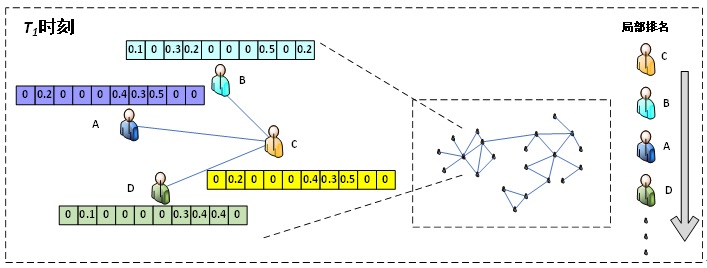 PDF(6782 KB)
PDF(6782 KB)


 PDF(6782 KB)
PDF(6782 KB)
 PDF(6782 KB)
PDF(6782 KB)
基于多智能体仿真的大学生群体竞争“内卷”机制研究
Research on the "involution" mechanism of college students' group competition based on multi-agent simulation
[目的/意义] 当前,“内卷”的流行成为一种文化现象,其所反映的社会现实问题更值得关注。厘清“内卷”的概念及特点,从定量的角度衡量“内卷”,有助于分析“内卷”的形成机制并寻求其破解路径。[方法/过程] 首先,梳理“内卷”概念的演化过程;其次,结合大学生群体竞争场景提出“内卷”的定量测度;再次,从网络拓扑、竞合策略及价值评价3个方面探索不同策略对仿真系统“内卷”程度影响;最后,结合上述实验结果,分别从个体和群体层面提出相应建议。[结果/结论] 随着网络拓扑中随机性的降低,系统“内卷”竞争程度越来越大。合作型策略可以提升系统的总产出,竞争型策略的系统总投入高,系统总产出却较低。而对于价值评价,全局模式下其在高投入、低回报和边际效用递减等特点上表现突出,“内卷”严重。
[Purpose/Significance] At present, the popularity of "involution" has become a cultural phenomenon, and the social reality it reflects deserves attention. Clarify the concept and characteristics of "involution" and measure it from a quantitative perspective, which helps to quickly seek the formation mechanism of "involution" and the path to solve it. [Method/Process] At first, the study explained the evolution of the concept of "involution". Secondly, the evaluation index of "involution" is constructed in relation to the competition scenario of university students. Finally, we analyzed the experimental results, and gave corresponding suggestions from the three dimensions of individual and group. [Result/Conclusion] As the randomness in the network topology decreases, the degree of competition for the "involution" of the system increases. The cooperative strategy can improve the total output of the system, while the total system input of the competitive strategy is high, but the total output of the system is low. On the whole, the value evaluation under the global mode is outstanding in the characteristics of high investment, low return and diminishing marginal utility, and the "involution" is serious.

involution / multi-agent simulation / knowledge flow / group learning competition
| [1] |
成庆.“内卷化”与意义世界的重建——兼与徐英瑾教授商榷[J].探索与争鸣, 2021(7):90-98.
|
| [2] |
王俊秀.“冷词热传”反映的社会心态及内在逻辑[J].人民论坛, 2021(15):96-99.
|
| [3] |
康德.判断力批判[M].邓晓芒, 译.北京:人民出版社, 2002:79.
|
| [4] |
GOLDENWEISER A. Loose ends of theory on the individual, pattern, and involution in primitive society[J]. Essays in anthropology, 1936: 99-104.
|
| [5] |
CLIFFORD G. Agricultural involution: the process of ecological change in indonesia[J]. Population studies, 1965(3):599-600.
|
| [6] |
黄宗智.略论华北近数百年的小农经济与社会变迁[J].中国社会经济史研究, 1986(2): 9-15.
|
| [7] |
赵泉民,井世洁.从“断裂”走向“互构”——转型社会中制度与人的协同构建论[J].人文杂志, 2011(5):173-181.
|
| [8] |
毛恩荣, 周志波.数字经济全球税收治理内卷化: 表征、根源与破局[J].宏观经济研究, 2021(8):28-47.
|
| [9] |
陈雯, 江立华.老龄化研究的“问题化”与老人福利内卷化[J].探索与争鸣, 2016(1):68-71.
|
| [10] |
章舜粤.专业术语不可被误用和滥用[J].人民论坛, 2020(33):61-63.
|
| [11] |
徐英瑾.数字拜物教: “内卷化”的本质[J].探索与争鸣, 2021(3):57-65.
|
| [12] |
王斌.从内卷到反卷:新时代青年的自我重构与治理对策[J].理论导刊,2022(1):104-109.
|
| [13] |
徐雯恬, 马丽娅.学习时代的超越: “内卷”现象的教育困境及突围[J].教学研究, 2021, 44(4):1-10.
|
| [14] |
金尚可, 王泗通.大学生学习“内卷化”的困境与突破[J].大众文艺, 2021(16):193-194.
|
| [15] |
苑津山, 幸泰杞.“入局与破局”: 高校学生内卷参与者的行为逻辑与身心自救[J].高教探索, 2021(10):123-128.
|
| [16] |
卢晓雯.多维视角下的内卷化: 研究现状及概念梳理[J].华中科技大学学报(社会科学版), 2021, 35(6):130-136.
|
| [17] |
林扬千.精疲力竭的突围: 大学生内卷化现象的表现、危害及应对[J].当代青年研究, 2021(3):88-93.
|
| [18] |
赵祥辉.博士生发表制度的“内卷化”: 表征、机理与矫治[J].高校教育管理, 2021, 15(3):104-113.
|
| [19] |
LAZEAR E P, ROSEN S. Rank-order tournaments as optimum labor contracts[J]. Journal of political economy, 1981, 89(5): 841-864.
|
| [20] |
GIBBONS R. An introduction to applicable game theory[J]. Journal of economic perspectives, 1997, 11(1): 127-149.
|
| [21] |
BANDURA A. Self-efficacy mechanism in human agency[J]. American psychologist, 1982, 37(2): 122.
|
| [22] |
WANG C, HUANG C, PAN Q, et al. Modeling the social dilemma of involution on a square lattice[J]. Chaos, solitons & fractals, 2022, 158: 112092.
|
| [23] |
WANG C, HUI K. Replicator dynamics for involution in an infinite well-mixed population[J]. Physics letters A, 2021, 420: 127759.
|
| [24] |
Boisot M H. Is your firm a creative destroyer? competitive learning and knowledge flows in the technological strategies of firms[J]. Research policy, 1995, 24(4): 489-506.
|
| [25] |
蔡宝来,林强,梁广,等. 在线教学环境下大学生学习方式转型研究:问题、趋势与发展路径[J]. 黑龙江高教研究,2020,38(12):140-144.
|
| [26] |
罗俊,戴瑞楠,张真.竞争机制会“卷”走合作行为吗?——来自公共品博弈实验的证据[J].经济科学,2022(2):126-141.
|
| [27] |
巴志超, 李纲, 朱世伟.科研合作网络的知识扩散机理研究[J].中国图书馆学报, 2016, 42(5): 68-84.
|
| [28] |
李纲, 巴志超.科研团队中知识粘滞的影响因素研究[J].中国图书馆学报, 2017, 43(1): 89-106.
|
| [29] |
NIETO A, DAVIES T, BORRION H. “Offending with the accomplices of my accomplices”: Evidence and implications regarding triadic closure in co-offending networks[J]. Social Networks, 2022, 70: 325-333.
|
| [30] |
WANG C, SZOLNOKI A. Involution game with spatio-temporal heterogeneity of social resources[J]. Applied mathematics and computation, 2022, 430: 127307.
|
| [31] |
张晓娟, 彭琳, 李倩.查询推荐研究综述[J].情报学报, 2019, 38(4):432-446.
|
| [32] |
吴江,贺超城,朱侯.集成复杂网络与多智能体仿真的人肉搜索效率研究[J].情报学报,2018,37(1):68-75.
|
| [33] |
贺超城,吴江,刘福珍等. 基于链网式组织形式的群体知识协作模拟研究[J].现代情报,2019,39(7):18-26.
|
黄茜:开展实验,论文撰写
左任衔:开展实验,论文撰写
唐振华:开展实验,论文撰写
/
| 〈 |
|
〉 |